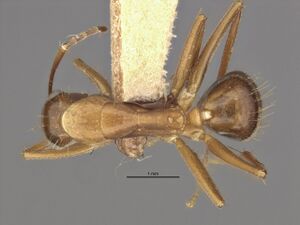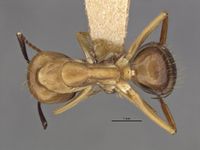Camponotus incensus
| Camponotus incensus | |
|---|---|

| |
| Scientific classification | |
| Kingdom: | Animalia |
| Phylum: | Arthropoda |
| Class: | Insecta |
| Order: | Hymenoptera |
| Family: | Formicidae |
| Subfamily: | Formicinae |
| Tribe: | Camponotini |
| Genus: | Camponotus |
| Species: | C. incensus |
| Binomial name | |
| Camponotus incensus Wheeler, W.M., 1932 | |
Identification
Distribution
Latitudinal Distribution Pattern
Latitudinal Range: 24.70292° to 24.70292°.
| North Temperate |
North Subtropical |
Tropical | South Subtropical |
South Temperate |
- Source: AntMaps
Distribution based on Regional Taxon Lists
Nearctic Region: United States (type locality).
Distribution based on AntMaps
Distribution based on AntWeb specimens
Check data from AntWeb
Countries Occupied
| Number of countries occupied by this species based on AntWiki Regional Taxon Lists. In general, fewer countries occupied indicates a narrower range, while more countries indicates a more widespread species. |

|
Estimated Abundance
| Relative abundance based on number of AntMaps records per species (this species within the purple bar). Fewer records (to the left) indicates a less abundant/encountered species while more records (to the right) indicates more abundant/encountered species. |

|
Biology
Castes
   
| |
| Worker (minor). . | Owned by Museum of Comparative Zoology. |
Nomenclature
The following information is derived from Barry Bolton's Online Catalogue of the Ants of the World.
- incensus. Camponotus (Tanaemyrmex) incensus Wheeler, W.M. 1932a: 14 (s.w.) U.S.A. (Florida).
- Status as species: Creighton, 1950a: 376; Smith, M.R. 1951a: 843; Smith, D.R. 1979: 1429; Bolton, 1995b: 104.
Type Material
- Syntype, 1 major and 2 minor workers, Pigeon Key, near Miami, Florida, United States, 6 May 1904, Wheeler, W.M..
Taxonomic Notes
It is likely this taxon is a synonym of Camponotus inaequalis (or its junior synonym Camponotus maculatus tortuganus) but until this entire group of species is revised its true status will remain unclear.
Unless otherwise noted the text for the remainder of this section is reported from the publication that includes the original description.
Description
Worker
Minor Length.6.3 mm.
Very similar to the minor of tortuganus but much smaller and paler, the epinotum distinctly more angulate in profile, the base straight and nearly concave, the declivity very short. Thorax paler than in tortuganus, front, clypeus and cheeks anteriorly yellow, mandibles brownish yellow; gaster colored like that of the major.
Major Length about 7 mm.
Resembling tortuganus but much smaller; (the latter measures 10-11 mm.) head of the same shape but proportionally shorter, with more acute anterolateral clypeal angles, more nearly straight, crenated anterior clypeal border, less impressed frontal area, posteriorly more approximated frontal carinae and somewhat shorter and more compressed antennal scapes. Thorax distinctly shorter with more convex and more even dorsal curvature, broader through the pronotum, which is less flattened above; base of epinotum forming a more distinct angle with the declivity. Grooves of the hind tibiae less distinct. Surface of body less sharply shagreened, so that the surface, especially of the occiput, posterior corners of the head and the thorax distinctly smoother and more shining. Cheeks and sides of head with sparse but shallow, elongate foveolae or coarse punctures, occiput with a radiating series of linear punctures and dorsal surface of pronotum with several similar impressions. Pilosity as in tortuganus, but paler yellow and pubescent on legs shorter. Color similar but the thorax is paler and more yellowish and the occiput and posterior corners of the head are paler, reddish brown. Gaster brown, paler than in tortuganus, the segments with a narrow dark brown hand near the pale posterior border.
References
- Smith, M.R. 1933. Additional species of Florida ants, with remarks. The Florida Entomologist 17: 21-26 (doi:10.2307/3492695).
- Smith, M. R. 1947f. A generic and subgeneric synopsis of the United States ants, based on the workers. Am. Midl. Nat. 37: 521-647.
- Wheeler, W. M. 1932a. A list of the ants of Florida with descriptions of new forms. Journal of the New York Entomological Society 40: 1-17.
References based on Global Ant Biodiversity Informatics
- Smith M. R. 1933. Additional species of Florida ants, with remarks. Florida Entomologist 17: 21-26.
- Wheeler W. M. 1932. A list of the ants of Florida with descriptions of new forms. J. N. Y. Entomol. Soc. 40: 1-17.

